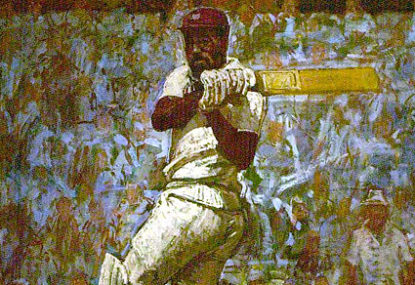In the 126 years since the first known declaration in cricket (Nottinghamshire declared at 5-157 against Kent in 1890), there have been many such brave decisions, and some have paid off handsomely.
Some, not so much.
April 12th 1976. Port of Spain.
India meet the West Indies in the third Test at Trinidad, one down in the series.
West Indies win the toss and elect to bat, but are soon reeling at 52 for 3 against the brilliantly unpredictable Chandrasekhar and his fast leg spinners. But Vivian Richards is in majestic form and on the back of his 177 runs, West Indies end Day 1 at 320 for 5, Chandra taking all five wickets.
The next morning, however, the wily Bishen Bedi wraps up the West Indian innings in quick time for 359.
On a turning Port of Spain pitch, Llyod believes that his three spinners will do more damage to the Indians than they inflicted on his batsmen. However it’s the sole effort of Michael Holding that breaks the back of the Indian batting.
Bowling with great pace and aggression, Holding gets Gavaskar cheaply and then runs through the Indian attack over the next day or so, taking six wickets as Chandra did in the previous innings, and India is all out for 228, a deficit of 131 runs.
Between Chandra and Venkat, the third member of India’s spinning trio in that Test, the Indians make rapid inroads into the West Indies batting dismissing Richards and Clive Lloyd relatively cheaply.
Despite a tentative century from Kallicharan, the West Indies only get to 271 for the loss of six wickets one hour after lunch on the fourth day and with a lead of 402 runs, Lloyd decides he has enough runs to dismiss the Indians cheaply with three spinners at his disposal on a broken track.
Two brothers-in-law batting for the Indian team, however, have other ideas. Gavaskar and Vishwanath, two of the smallest batsmen in Test cricket, score gritty magnificent centuries on a difficult pitch.
Mohinder Amarnath bats for 400 minutes to score 85, and a bearded Brijesh Patel comes in with the mandatory overs half done, and smashes the West Indian spinners all over the park to take India to a famous and unscripted victory.
It’s the first time since 1948/49 when Bradman’s Australia achieved the feat, that a team has scored more than 400 to win in the fourth innings after a declaration by the opposition.
This loss however has a much bigger impact on the future of world cricket than people could imagine.
Lloyd is incensed at the impotence of his spinners on a turning track, and brings in a four-pacer attack for the final Test of the series to pound the Indians into submission.
It’s the start of the West Indies pace quartet domination that is to rule cricket fields from Port of Spain to Eden Gardens for more than a decade.
January 18th 2000. Centurion.
This is a match that has gone down in history as the best example of something that appears to be too good to be true, and sure enough, it is.
South Africa comes into the fifth Test at Centurion having won the series 2-0 and with little to prove against the hapless English team.
South Africa struggle to 155 for 6 on a rain-curtailed first day. Then incessant rain means the next three days are washed out. So the obvious conclusion on Day 5 is that the Test will end in a tame draw.
Before play resumes however, South African captain Hansie Cronje bumps into Alec Stewart on the stairs and asks if Nassir Hussain would consider an offer to chase 270 in 73 overs to give England a chance to fight for a victory.
With South Africa up 2-0, it would not impact the result of the series, and the paying public would get something for their money. Hussain and Coach Fletcher decide to see how the first session goes before responding.
When South Africa restart play, the pitch plays true and Klusener and Pollock bat well, and Darren Gough doesn’t bowl well.
40 minutes into the day’s play, Hussain decides to test Cronje by sending him a message asking whether South Africa would be willing to let England try and chase 250 instead.
Much to his surprise, Cronje agrees, and in fact tells Hussain he can score 245 from 76 overs instead, an even better offer.
What happens next is pure Hollywood.
South Africa declares at 248 for 8. England then declares without playing a ball – the first time a team has ever declared at 0 for 0. South Africa then forfeits its innings, leaving England to score 249 runs to win the match.
England duly scores 251 for 8 to win the match. Michael Atherton describes the victory as “the cheapest win of my Test career”.
There is a lot of talk around the match, and while most of the media praises the arrangement, Derek Pringle, writing in The Independent, questions Cronje’s motives, calling it an action out of character.
On April 12th the same year, the fixing scandal breaks out, and three days later comes confirmation that Cronje was offered $150,000 by a bookie to be paid to a charity to ensure that the Centurion Test had a positive result.
The Centurion remains a black mark forever in Test cricket history, and a huge lesson to everyone that what looks too good to be true, usually is.
As always, this piece is not meant to be a defining list of great victories that resulted from ill-conceived declarations, but instead, another piece that should whet the appetite of Roarers to kick off a discussion of their favourites!
Let the opinions roll!





























































































